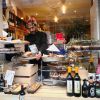- Accede I
- Regístrate I
- carrito
5. Mercado de Abastos, la catedral del sabor
Saliendo del Preguntoiro hacia la Praza da Pescadería Vella y la Praza de Santo Agostiño, encontramos el Mercado de Abastos de Santiago, hoy referencia de toda la comarca y considerado uno de los cuatro mejores de España.
El mercado nació en el siglo XIX ubicado en los terrenos del palacio de los Condes de Altamira. En 1941 adquirió su aspecto actual, que es el de ocho naves de granito con forma de iglesias y reminiscencias románicas.
En ‘la Plaza’, como la llaman los compostelanos, salta a la vista el color de las frutas y verduras procedentes de explotaciones familiares, cultivadas de manera artesanal y vendidas directamente por las propias productoras, las ‘paisanas’, que ocupan los espacios exteriores, ofreciendo también quesos, conejos, pollos de corral, huevos camperos... Entre ellas están las ‘pementeiras’ o vendedoras del pimiento de Padrón, un producto que llegó para quedarse en el siglo XVI traído por los franciscanos desde México. De Galicia son excelentes las patatas, especialmente las de la variedad Kennebec. Son sus mejores compañeras dos partes distintas de la planta del nabo, típicas del otoño y el invierno: las nabizas, es decir, las primeras hojas (recogidas allá por octubre), parte fundamental del caldo gallego; y los grelos, que son los gruesos tallos de la floración con sus hojas, que figura en el cocido gallego, junto con carnes de cerdo, ternera y gallina, chorizos, patatas, garbanzos o alubias. Todo ello está fresquito en el mercado.
Pero hay más. Los grandes protagonistas del mercado son crustáceos, moluscos y peces de las rías gallegas, conocidos en todo el país por su calidad y sabor. Hay también muchos establecimientos dedicados a la venta de carne de la región, tanto de vacuno como de cerdo. De éste, como dice el dicho, ‘se aprovecha todo’: la matanza ocurre alrededor del día de San Martín, y tras el despiece se destina tanto a carne fresca como a embutidos: ‘androllas’, ‘botelos’, chorizos… Las carnes saladas y curadas entran en la elaboración de caldo gallego, cocidos, lacón (pata delantera curada) con grelos y otros platos. No faltan la ‘cachola’ (cabeza entera, muy apreciada alrededor del Carnaval), la ‘orella’ y hasta las ‘unllas’ (manos), que por sí solas protagonizan una fiesta gastronómica en el barrio compostelano de San Lázaro. La carne de cerdo fresca tiene en Compostela dos estrellas indudables: el jamón asado y el ‘raxo’, lomo en trocitos al ajillo.
En vacuno Galicia cuenta con la principal indicación geográfica protegida de España: Ternera Gallega, procedente de animales de menos de 12 meses, criados en los pastos de Galicia y preferentemente procedentes de razas gallegas y sus cruces. En restaurantes y casas de comida se ofrecen con frecuencia la ternera asada con patatas y pimiento morrón, y la ‘carne ó caldeiro’, falda de ternera cocida aderezada con un polvo de pimentón y aceite de oliva.
Asimismo, encontraremos en nuestro paseo por el mercado, tiendas de otros productos como panaderías (donde comprar la típica empanada gallega), pastelerías (para hacerse con la genuina Tarta de Santiago), charcuterías (con una gran variedad de quesos gallegos), tiendas de aceite, de vinos, etc.
La nave número 5 se dedica a la restauración y los establecimientos que están ubicados en la Rúa das Ameas, que también pertenecen al mercado, venden sobre todo artesanía gallega y obra de autor como fotografías, bolsos, joyas y regalos.
El Mercado de Abastos abre todos los días excepto los domingos.
En sus alrededores, en la Rúa das Ameas y Praza de Santo Agostiño, bajo el cobijo de la actividad del propio Mercado, han surgido locales de restauración que lo convierten en un punto de encuentro para compostelanos y turistas: Abastos 2.0, La Radio de Pepe Solla, A Lonxa do Mercado, Lume, O Ghalpón de Abastos, Café de Altamira, Casa Pepe, La Sucursal de Moha, etc.



















